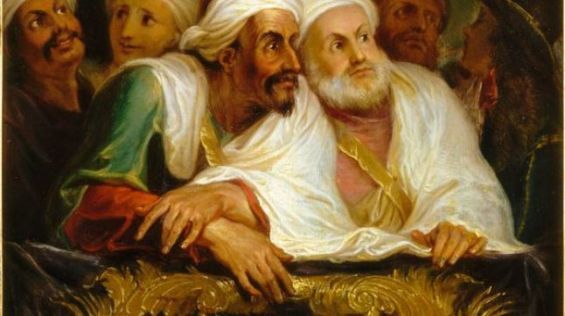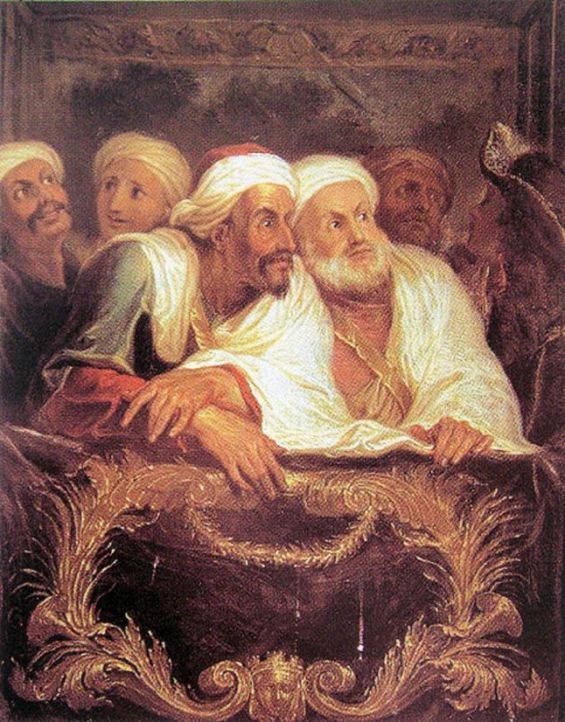For more than 4 months, the exhibition «Visiteurs de Versailles 1682-1789» held at the Palace of Versailles, former residence of Louis XIV, Louis XV and Louis XVI, will host a number of precious paintings. The Cultural event that will last until the 25th of February 2018 is organized by the Metropolitan Museum of Art and the Palace of Versailles.
The most exciting thing for Moroccans about the exhibition is that it is featuring the painting of the Moroccan ambassador Mohammed Temim, «Mohammed Temim, Ambassadeur du Maroc, a la Comédie Italienne», painted by Antoine Coypel, circa 1682. The painting immortalizes the extraordinary visit, January 1682, of the Moroccan ambassador Hajj Mohammed Temim Attitouani aka Mohammed Temim to Paris.
Governor of Tetouan then Salé, Mohammed Temim was the emissary of the Alaouite Sultan Moulay Ismail ibn Sharif sent to negotiate with King Louis XVI a possible ratification of a treaty signed a year earlier by Morocco and France on July 13, 1681.
Sultan Moulay Ismail, the warrior king
In 1672, Moulay Ismail, the seventh son of Moulay Sharif, founder of the Alaouite dynasty, has been elected sultan of the North African kingdom. The reign of the Alaouite sultan was marked by his ability to unify the kingdom all while strengthening it status. He carried one of the strongest military campaigns in the region fighting the Ottoman Turks and the Spanish. He also possessed over 150,000 men from sub-Saharan Africa who served in his elite Black Guard and which helped the Sultan to conquer the whole Morocco from European kingdoms.

After spending several years trying to bring order to a country weakened by internal tribal wars, Moulay Ismail launched in 1681 a campaign to free the ports of the kingdom. Indeed, by the end of the sixteenth century, the city of Mehdia, called back then Maamoura, was controlled by pirates. To respond to the corsairs’ attacks, the Spanish tried to seize it twice. In 1611, they tried to make the port of the city unusable by sinking there 8 ships. The Spaniards came back in 1614 with a 100-ship fleet to finish what they started three years ago. As a result, the port of Al Maamoura got occupied until 1681, the year when Sultan Moulay Ismail managed to kick out the occupants and seize back the port. The same day, a treaty was signed by the sultan and a representative of France in Morocco against Spain and Great Britain. The treaty also evoked the case of Moroccans captured by French ships.
Indeed, a year earlier, around 228 Moroccans were captured by French ships, as reported by Nabil Matar in his book «In the lands of Christians : Arabic travel Writing in the Seventeenth Century» (Editions Psychology Press, 2003).
The Moroccan ambassador's suprise in a painting
On the 21st of September 1681, Moulay Ismail chose to name the governor of Tetouan, Mohammed Temim, his emissary for King Laouis XIV. His mission was to negotiate with the French monarch the ratification of the treaty signed in 1681 and freeing Moroccans captured by the French.
Mohammed Temim, accompanied by Ali Maaninou and six other diplomats sailed to France. Although the Moroccan delegation came across a number of difficulties on its way to Paris, it arrived in Brest on the 7th of October after a trip that lasted 3 months and 10 days. The emissary was then received by Louis XIV at the castle of Saint-Germain-en-Laye on the 4th of January 1681. It was an opportunity for Mohammed Temim and his companions to attend several cultural events, according to Nabil Matar.
«In January 1682, the Moroccan ambassador Mohammed Temim and seven members of his retinue visited France and discovered the social, artistic and intellectual innovation of the country. The ambassador attended an opera, De Lully’s Atys, where he 'showed much surprise', probably at the amazing stage scenery that included (a mountain consecretated for Sybil) along with a temple, palace and gardens».
It was during this event that painter Antoine Coypel transformed the Moroccan ambassador’s surprise into a painting.

Mohammed Temim also attended a ballet at the Royal Academy of Music. A week later, he visited Notre Dame Cathedral in Paris and an organ recital. «This ambassador is curious about everything that concerns sciences and arts…» commented a French interpreter who accompanied Sultan Moulay Ismail’s envoy.
French-Moroccan diplomatic relations
On the 25th of February, when he returned to Morocco, Mohammed Temim received a set of beautiful farewell gifts from Louis XIV. However, the visit described by Nabil Matar as successful, was differently regarded by «Mémoires du Patrimoine Marocain» (Fourth volume, Editions Organization, 1986), which gives a different version of the famous diplomatic mission. Although during the visit of the Sultan’s ambassador, an agreement was signed, Morocco did not free its nationals imprisoned in France. In fact, Louis XIV, asked his generals to hide the Moroccan prisoners and to say before Temim that France has no Moroccans in its prisons.

Diplomatic relations between the French Monarch and the Alaouite Sultan were officially broken in 1708. Until that date, Louis XIV refused to exchange the Moroccan captives with the French ones, brandishing an article on the redemption to prisoners. The situation worsened in 1687 when the French king dictated a law prohibiting the export of food and military products to foreign countries, including Morocco.
«Mémoires du patrimoine marocain» even quotes a correspondence addressed to the French people by their king, who says he learned that despite the ban, products were being «transferred by corsairs to Morocco.»
This will not prevent Sultan Moulay Ismail from reserving a special place for Louis XVI. The Shereefian Sultan had even asked for the hand of Marie Anne de Bourbon, Princess of Conti and daughter of Louis XIV. A request that was obviously be declined.





 chargement...
chargement...













